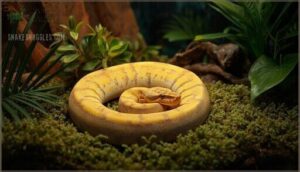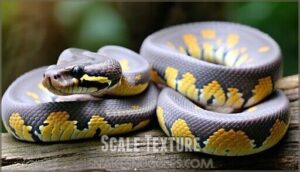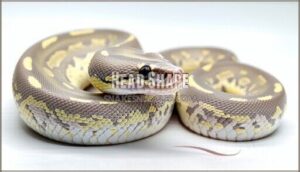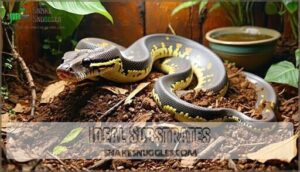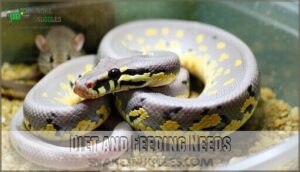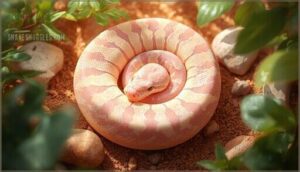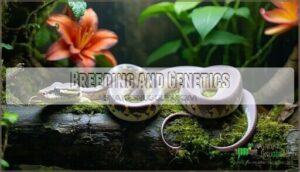This site is supported by our readers. We may earn a commission, at no cost to you, if you purchase through links.
 Pastel ball pythons are stunning co-dominant morphs that’ll steal your heart with their golden hues and enhanced patterns.
Pastel ball pythons are stunning co-dominant morphs that’ll steal your heart with their golden hues and enhanced patterns.
You’re looking at a docile snake that reaches 3-5 feet, lives 20-30 years, and makes an excellent beginner pet.
They need 88-92°F basking spots, 50-60% humidity, and frozen-thawed rodents every 1-2 weeks.
Their calm temperament means handling sessions are stress-free for both of you.
The pastel gene brightens colors and reduces dark pigmentation, creating that signature "washed-out" look that’s anything but boring.
These genetic gems breed true, making them foundation animals for countless designer combinations that’ll blow your mind.
Table Of Contents
- Key Takeaways
- Pastel Ball Python Overview
- Pastel Ball Python Appearance
- Size and Weight Variations
- Lifespan and Longevity
- Habitat and Enclosure Requirements
- Diet and Feeding Needs
- Behavior and Temperament
- Breeding and Genetics
- Frequently Asked Questions (FAQs)
- How to care for a pastel ball python?
- How long do pastel ball pythons live?
- How big do pastel ball pythons get?
- Can you leave a heat lamp on 24/7 for ball python?
- How much do pastel ball pythons cost?
- What health problems affect pastel ball pythons?
- Are pastel ball pythons good for beginners?
- How often should pastel ball pythons shed?
- Can pastel ball pythons live with other snakes?
- Conclusion
Key Takeaways
- You’ll get a docile, beginner-friendly snake that reaches 3-5 feet and lives 25-30 years with proper care, making pastels perfect long-term companions for first-time snake owners.
- You need to maintain 88-92°F basking spots, 50-60% humidity, and feed frozen-thawed rodents every 1-2 weeks to keep your pastel healthy and thriving.
- You’re looking at co-dominant genetics that brighten colors and reduce dark pigmentation, creating that signature golden "washed-out" look that’s actually stunning.
- You can breed two pastels together to create super pastels with enhanced purple blushing effects, making them valuable foundation animals for countless designer morph combinations.
Pastel Ball Python Overview
You’ll discover that pastel ball pythons are a co-dominant genetic mutation first bred in 1997, creating one of the most important foundation morphs in modern snake breeding.
These vibrant serpents display brighter yellow coloration and cleaner belly patterns than normal ball pythons, making them perfect starter snakes for both beginners and experienced keepers.
History and Discovery
Back in 1997, your favorite pastel ball python‘s discovery story began when Greg Graziani and Kevin McCurley at NERD stumbled upon this stunning mutation.
The genetic goldmine that revolutionized snake breeding started with one lucky discovery at NERD.
The mutation origins trace to Africa’s wild populations, where nature crafted the founder lineage that revolutionized ball python origin stories forever.
These breeding history pioneers didn’t know they’d uncovered ball python genetics gold. The discovery was a significant event in the history of ball python breeding, and it has had a lasting impact on the understanding of ball python genetics.
Genetic Research
The pastel ball python genetic mutation operates through specific gene expression patterns that researchers have mapped since its discovery.
Understanding DNA testing and heredity patterns helps you predict breeding outcomes with remarkable accuracy.
Here’s what genetic research reveals about ball python genetics:
- Mutation Types – Pastel exhibits codominant inheritance, meaning one copy creates visual changes
- Breed Predictions – You can calculate exact offspring ratios using Punnett squares
- Ball Python Genetic Inheritance – Eastern Michigan University sequences morphs for genome comparison
- DNA Testing – Shed skin provides non-invasive samples for genetic analysis
- Gene Expression – Research identifies specific loci controlling color and pattern variations
Foundation Morph
Since their discovery in 1997, pastel ball pythons have become the building blocks of modern snake breeding.
You’ll find these codominant mutation snakes in countless breeding projects today. Their genetic stability makes them perfect for creating complex ball python morphs and studying morph genetics.
The pastel ball python’s unique appearance is due to its genetic color variations.
| Breeding Aspect | Pastel Foundation Role |
|---|---|
| Genetic Research | First documented codominant mutation |
| Color Patterns | Enhanced yellows and reduced browns |
| Morph Variations | Creates super pastel when bred together |
| Snake Breeding | Essential for complex ball python genetics |
Pastel Ball Python Appearance
You’ll immediately notice that pastel ball pythons display brighter, more vibrant colors than their normal counterparts, with distinctive yellow hues replacing the typical brown pigmentation and clean white bellies free from dark checkering.
Their most striking features include the characteristic "blushing" effect on their head and spine scales, sharp dark markings with lighter undertones, and often green or gold eyes that make them stand out from regular ball pythons, showcasing their unique vibrant colors.
Color Morphs
You’ll find pastel ball pythons showcase remarkable color variations that make each snake unique.
Their lighter pigmentation creates stunning visual combinations when bred with other ball python morphs.
Here are five popular pastel color combinations:
- Pastel Banana – Golden yellow tones with vibrant contrast
- Pastel Clown – Bold patterns with reduced dark pigmentation
- Pastel Piebald – White patches mixed with pastel coloring
- Pastel Axanthic – Silver-gray tones replacing typical yellows
- Super Pastel – Enhanced brightness with purple blushing effects
Scale Texture
Looking beyond the vibrant colors, you’ll notice your pastel ball python’s scales tell their own story.
These reptiles display distinct texture types that set them apart from regular ball pythons.
The scales feel smooth yet firm, creating unique scale patterns across their body.
| Scale Feature | Normal Ball Python | Pastel Ball Python |
|---|---|---|
| Surface Feel | Standard smooth | Enhanced smoothness |
| Pattern Definition | Moderate clarity | Sharp, clean edges |
| Blushing Effect | Minimal to none | Prominent highlights |
Understanding these ball python characteristics helps with proper ball python care and identifying authentic pattern morphs in ball python genetics.
Head Shape
When examining pastel ball pythons, you’ll notice their head structure displays sharp definition with lighter undertones that set them apart from standard ball python morphs.
The skull shape maintains the classic triangular profile, but facial features show enhanced contrast.
Scale patterns around the jaw alignment create distinct borders, while ball python genetics influence the overall head proportions and pastel ball python appearance, which is characterized by its unique definition.
Size and Weight Variations
You’ll find that pastel ball pythons typically reach 3-5 feet in length, with females growing noticeably larger than males in both size and weight.
Your snake’s final dimensions depend on genetics and sex, as females can stretch up to 6 feet while some males stay compact at just 2 feet long, influenced by their sex.
Average Length
When measuring your pastel ball python’s average length, you’ll typically find they reach 3-5 feet in captivity.
Length variations depend on genetics, diet, and care quality.
Growth rates peak during their first two years, with proper ball python care ensuring healthy development.
These size factors make measurement tips essential for tracking your snake’s progress and overall ball python lifespan expectations, which is influenced by proper care quality.
Sexual Dimorphism
Sexual dimorphism in Python regius becomes apparent as your snake matures.
Female size consistently exceeds males, with ladies reaching 4-6 feet while gentlemen typically max out around 3-4 feet.
Gender determination relies on dimorphic traits like vestigial spurs—males sport larger, more prominent spurs near their vents.
Growth rates also differ, with females packing on weight faster than their male counterparts in this ball python species, exhibiting distinct growth rates.
Hatchling Size
Your pastel ball python’s journey begins remarkably small. Baby snakes emerge from their eggs measuring just 10-12 inches long, weighing about 50-100 grams.
These neonate care requirements differ substantially from adults, as hatchlings need:
- Smaller prey items like adult mice or fuzzy rats
- More frequent feeding schedules every 5-7 days
- Tighter security since small ball pythons escape easily.
Juvenile growth happens fast—they’ll double in size within three months, which is a remarkable change, and this growth phase is critical for their development.
Lifespan and Longevity
You’ll be amazed to learn that your pastel ball python can live 25-30 years in captivity with proper care, making them a long-term companion that might outlast your college years and well into your career.
While their wild cousins typically survive only 10-15 years due to predators and environmental challenges, captive pythons have reached the impressive age of 47 years when provided with consistent temperatures, humidity, and regular veterinary checkups, which is a remarkable achievement.
Captive Lifespan
With proper captive care, your pastel ball python can become a decades-long companion.
These remarkable reptiles typically live 25-30 years in captivity, with some reaching their 40s through excellent husbandry.
| Longevity Factors | Impact on Lifespan |
|---|---|
| Proper Temperature | Prevents health issues |
| Consistent Humidity | Reduces respiratory problems |
| Quality Diet | Supports aging process |
| Regular Vet Checkups | Early disease detection |
Survival rates dramatically improve when you address potential health issues early and maintain consistent environmental conditions throughout their lengthy lives, which is crucial for their longevity and overall well-being.
Wild Lifespan
In the wild, ball python lifespan averages 10-15 years due to environmental challenges.
Wild survival faces threats from habitat loss, predators, and disease that don’t affect captive specimens.
The ball python species demonstrates remarkable snake longevity despite these pressures.
Environmental impact and conservation status remain stable, though pastel ball pythons exist only in captivity, never occurring naturally in African ecosystems, which is a key aspect of their conservation status.
Proper Care
Your pastel ball python’s longevity depends heavily on consistent ball python care practices.
Enclosure maintenance involves weekly spot-cleaning and monthly deep sanitization. Temperature control requires monitoring your ball python temperature gradient daily with digital thermometers.
Humidity management prevents respiratory infections, while proper substrate selection supports natural behaviors.
Regular health monitoring catches issues early, ensuring your ball python enclosure creates ideal conditions for decades of companionship. Understanding the importance of proper snake care is vital for maximizing your pet’s lifespan.
Habitat and Enclosure Requirements
Creating the perfect habitat for your pastel ball python isn’t rocket science, but getting the temperature, humidity, and substrate right will make the difference between a stressed snake and a thriving one.
You’ll need to maintain specific environmental conditions that mimic their natural African habitat, including a temperature gradient of 75-94°F and humidity levels between 50-60%, to ensure your snake’s well-being and create a thriving environment with the right humidity levels.
Ideal Substrates
Your snake’s comfort starts from the ground up. Choose cypress mulch, coconut fiber, or pesticide-free topsoil as your best substrate options.
These reptile substrate choices excel at moisture control while allowing natural burrowing behaviors. Avoid cedar or pine shavings that can irritate respiratory systems.
Quality ball python substrate maintains proper humidity levels without becoming soggy, creating the perfect foundation for your pet’s health. Proper reptile substrate selection is essential for a healthy environment.
Temperature Gradient
Creating the perfect thermal gradient transforms your pastel ball python’s enclosure into a comfortable home.
You’ll need three distinct temperature zones to mimic their natural African habitat:
- Cool side: 75-80°F for relaxation
- Warm side: 84-89°F for daily activities
- Basking spot: 90-94°F for thermoregulation
Use ceramic heat emitters or under-tank heaters as reliable heat sources for consistent temperature control.
Proper heat emitter systems are essential for maintaining ideal temperatures in the enclosure.
Humidity Levels
Beyond temperature regulation, your pastel ball python’s health depends heavily on maintaining proper humidity levels between 50-60%.
Low humidity causes stuck sheds and respiratory issues, while excessive moisture promotes bacterial growth and scale rot.
| Humidity Level | Effects | Solutions |
|---|---|---|
| Below 50% | Stuck sheds, dehydration | Add larger water bowl, mist substrate |
| 50-60% (Ideal) | Healthy shedding, comfort | Monitor with hygrometer, maintain balance |
| Above 70% | Scale rot, infections | Improve ventilation, reduce water sources |
The importance of maintaining the ideal humidity range cannot be overstated, as it directly impacts the snake’s overall health and well-being, including preventing stuck sheds and respiratory issues.
Diet and Feeding Needs
Your pastel ball python’s diet is surprisingly simple—they’re obligate carnivores that eat whole prey items like mice and rats.
Their feeding frequency depends on their age and size, and you’ll need to establish a consistent feeding schedule.
You must also provide fresh water at all times, as proper nutrition directly impacts their health, growth, and vibrant coloration.
Food Sources
Being obligate carnivores, your pastel ball python thrives on a diet of whole prey items that mirror their natural food chains.
These snakes have specific nutrient needs that only complete rodents can satisfy, making proper prey selection vital for their carnivorous lifestyle.
- Frozen/thawed rats and mice – Primary food sources that provide complete nutrition
- Alternative rodents – Gerbils and hamsters for variety in your python feeding schedule
- Occasional birds – Baby chicks or quail for finicky eaters following feeding tips
- Proper sizing – Prey shouldn’t exceed your snake’s widest body section for safe consumption
When selecting frozen prey, understanding frozen rat nutrition is essential for a balanced diet.
Feeding Schedule
Your ball python feeding schedule depends on age and size.
Young snakes need weekly meals, while adults eat every 2-3 weeks.
Here’s your feeding roadmap:
| Age Group | Feeding Times | Meal Size |
|---|---|---|
| Hatchlings (0-6 months) | Every 5-7 days | Fuzzy mice |
| Juveniles (6-18 months) | Every 7-10 days | Adult mice |
| Sub-adults (18+ months) | Every 10-14 days | Large mice |
| Adults (3+ years) | Every 14-21 days | Rats |
| Breeding females | Every 10-14 days | Large rats |
The provided table outlines the specific feeding times and meal sizes for each age group of ball pythons, ensuring a clear and comprehensive guide for their care.
Water Requirements
Your pastel ball python’s hydration needs go beyond just filling any old bowl.
Choose a heavy snake water dish that’s wide enough for soaking but not so deep they’ll struggle. Fresh, dechlorinated water at room temperature works best.
The reptile water dish doubles as humidity control, maintaining those essential 50-60% humidity levels naturally.
Behavior and Temperament
You’ll find that pastel ball pythons exhibit the same calm, docile temperament that makes regular ball pythons such popular pets for both beginners and experienced keepers.
Their gentle nature means they rarely bite or show aggression, though they’ll still curl into their characteristic defensive ball when startled—a behavior that’s more endearing than intimidating once you understand it’s simply their way of saying "I need a moment.
They exhibit this behavior because it’s a natural response, and understanding this can help build a stronger bond between the pet and the owner, based on trust and mutual respect.
Docile Nature
Once they’ve had their fill, your pastel ball python transforms into the perfect roommate. These snakes earned their reputation as gentle pets through centuries of evolution as ambush predators.
Their calm temperament makes them ideal for beginners and seasoned keepers alike. Here’s what makes their docile nature special:
- Naturally shy personality reduces defensive behaviors
- Slow, deliberate movements minimize startling reactions
- Stress-resistant disposition adapts well to captive environments
Understanding the snake care basics is essential for providing a comfortable environment for your pet.
Handling Tips
Confidence builds the foundation for successful snake handling with your pastel ball python.
Support their body with gentle touch, using both hands to distribute weight evenly. Move slowly and avoid sudden restraint methods that trigger defensive responses.
Start with brief five-minute sessions, gradually increasing duration as trust develops. These calming techniques guarantee positive ball python handling experiences while respecting their natural ball python temperament and building lasting snake trust.
These methods ensure positive ball python handling experiences and help in building lasting relationships with your pet.
Socialization
While regular snake handling builds trust, true socialization goes deeper than simple contact.
Your pastel develops confidence through consistent environmental enrichment and gentle taming techniques that respect their natural ball python temperament.
Create positive associations through:
- Predictable routines during feeding and maintenance
- Calm interactions that reinforce owner bonding
- Enriched environments promoting natural ball python behavior.
Social learning happens gradually—patience trumps persistence every time.
Breeding and Genetics
When you’re ready to understand pastel ball python genetics, you’ll discover that the pastel gene works as a co-dominant mutation, meaning it can produce three distinct outcomes in offspring.
You’ll find that breeding two pastels together creates the stunning "super pastel" morph, which displays enhanced coloration and the coveted purple blushing that makes these snakes so prized among reptile enthusiasts.
Co-Dominant Mutation
Understanding the genetic code behind pastel ball pythons reveals fascinating mutation types at work.
This co-dominant mutation exhibits incomplete dominance, creating beautiful intermediate traits when you breed pastels with normals.
Unlike simple dominant traits, co-dominant effects produce visible changes in heterozygous offspring.
This python morph demonstrates how genetics creates the stunning variations that make ball python breeding so enticing for enthusiasts, showcasing the beauty of co-dominant effects.
Super Pastel Morph
When you breed two pastel ball pythons together, you’ll discover the stunning super pastel ball python—a genetic jackpot that showcases enhanced Super Pastel Genetics.
Breeding two pastels unlocks nature’s genetic treasure chest—the dazzling super pastel with its purple-kissed brilliance.
This ball python morph guide reveals how Pastel Inheritance creates dramatically intensified colors and patterns through dominant Genetic Expression.
- Color Intensity: Super pastels display vibrant yellows and oranges that practically glow under proper lighting
- Morph Patterns: Enhanced blushing creates irregular, flowing designs across the entire body length
- Purple undertones: Distinctive lavender hues earn them the nickname "Purple Haze" among breeders
- Pattern disruption: Normal ball python genetics get scrambled, producing unique, unpredictable markings
- Eye coloration: Striking green or gold eyes complement the intensified body pigmentation perfectly
Understanding the pastel ball python’s genetic traits is essential for successful breeding and care of these unique animals.
Genetic Variations
Beyond the super pastel’s striking appearance lies a fascinating world of genetic code complexity.
Pastel ball pythons showcase diverse mutation types and inheritance patterns that’ll amaze you.
Understanding ball python genetics inheritance helps predict morph development outcomes.
Genetic variations drive ball python genetic research forward, revealing new possibilities for breeders.
| Mutation Type | Inheritance Pattern | Gene Expression |
|---|---|---|
| Co-dominant | 50% offspring carry trait | Variable intensity levels |
| Incomplete dominant | Blended characteristics | Gradual color shifts |
| Simple recessive | 25% visual offspring | All-or-nothing expression |
| Polygenic | Multiple genes involved | Complex trait combinations |
Gene expression varies between lineages, creating unique dominant traits.
This complexity is a key aspect of ball python genetics, making it a complex field of study.
Frequently Asked Questions (FAQs)
How to care for a pastel ball python?
You’ll need a 40-gallon tank with proper heating, maintaining temperatures between 75-95°F.
Keep humidity at 50-60%, provide hiding spots, and use cypress mulch substrate.
Feed appropriately-sized prey every 1-2 weeks.
How long do pastel ball pythons live?
You’ll enjoy your pastel ball python’s company for decades—they typically live 25-30 years in captivity with proper care.
Some exceptional specimens have reached 47 years, making them true lifelong companions worth the commitment.
How big do pastel ball pythons get?
Females can reach six feet while males typically max out around four feet—that’s quite the size difference.
You’ll find most pastel ball pythons grow between three to five feet long, with females consistently outgrowing their male counterparts, showcasing a notable growth pattern.
Can you leave a heat lamp on 24/7 for ball python?
Don’t leave your heat lamp on 24/7 for your ball python.
They need a natural day-night cycle with 12 hours on and 12 hours off to maintain proper circadian rhythms and healthy behavior patterns.
How much do pastel ball pythons cost?
Looking for your first pastel ball python? You’ll typically spend $75-100 for these stunning morphs, making them surprisingly affordable foundation snakes.
They’re budget-friendly compared to rarer morphs while offering beautiful coloration.
What health problems affect pastel ball pythons?
You’ll encounter respiratory infections, scale rot, mites, and shedding problems if humidity and temperature aren’t properly maintained.
Metabolic bone disease can develop from poor nutrition, while stuck sheds indicate inadequate moisture levels in your snake’s environment, which can be related to inadequate moisture.
Are pastel ball pythons good for beginners?
Yes, you’ll find pastel ball pythons are perfect starter snakes.
They’re docile, easy to handle, and forgiving of minor care mistakes.
Their calm temperament and straightforward needs make them ideal for first-time snake owners, with a particularly forgiving nature.
How often should pastel ball pythons shed?
Ball pythons shed approximately every 4-8 weeks, with younger snakes shedding more frequently than adults.
You’ll notice your pastel’s eyes turning milky blue before shedding – this "opaque" phase signals it’s time to increase humidity slightly.
Can pastel ball pythons live with other snakes?
You shouldn’t house pastel ball pythons with other snakes.
They’re solitary creatures who’ll compete for resources, spread diseases, and stress each other out.
Keep them separate for their health and happiness.
Conclusion
Understanding pastel ball pythons everything you need to know reveals why these morphs remain reptile keeping’s most beloved foundation animals.
You’ve discovered their gentle temperament makes handling enjoyable, while their straightforward care requirements suit beginners perfectly.
Their co-dominant genetics create endless breeding possibilities, from subtle pastels to striking super forms.
Whether you’re starting your first collection or expanding existing projects, pastels offer reliability and beauty that’ll reward your dedication for decades to come.

